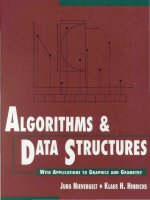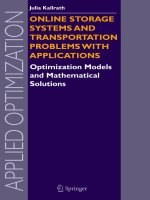online storage systems and transportation problems with applications
Bạn đang xem bản rút gọn của tài liệu. Xem và tải ngay bản đầy đủ của tài liệu tại đây (12.54 MB, 237 trang )
Online Storage Systems and
Transportation Problems
with Applications
Applied Optimization
Volume 91
Series Editors:
Panos M. Pardalos
University of Florida, U.S.A.
Donald W. Hearn
University of Florida, U.S.A.
Online Storage Systems and
Transportation Problems
with Applications
Optimization Models and
Mathematical Solutions
by
Julia Kallrath
ITWM, Germany
Springer
eBook ISBN: 0-387-23485-3
Print ISBN: 1-4020-2971-3
Print ©2005 Springer Science + Business Media, Inc.
All rights reserved
No part of this eBook may be reproduced or transmitted in any form or by any means, electronic,
mechanical, recording, or otherwise, without written consent from the Publisher
Created in the United States of America
Boston
©2005 Springer Science + Business Media, Inc.
Visit Springer's eBookstore at:
and the Springer Global Website Online at:
to my parents
This page intentionally left blank
Contents
Dedication
Preface
1.
INTRODUCTION
1.1
Optimization Everywhere
2.
BATCH PRESORTING PROBLEMS. I
2.1
2.2
Problem Description and Classification
Formulation of the Batch Presorting Problem
2.2.1
2.2.2
2.2.3
Feasible Permutations
Mathematical Formulation of
Mathematical Formulation of and
2.2.3.1
2.2.3.2
An Optimization Version of
An Optimization Version of
2.3
2.4
Complexity Results
Polynomial Subcases
2.4.1
2.4.2
Reformulation of and
An Alternative Model Formulation of
2.5
The Case of Two Layers
2.5.1
2.5.2
2.5.3
Offline Situations
Online Situations
Algorithms for Online Situations with Lookahead
2.5.3.1
2.5.3.2
2.5.3.3
2.5.3.4
Definition of a Lookahead
An Algorithm with a Weak Lookahead, size
Algorithms with a Weak Lookahead, size
An Algorithm with a Strong Lookahead
2.5.4
Competitive Analysis
v
xi
1
1
5
5
6
7
8
10
11
13
15
21
21
22
25
26
30
33
33
34
35
37
37
viii
Online Storage Systems and Transportation Problems
2.5.5
Comparison of and Online Algorithms with
Lookahead
2.6
2.7
Extensions
Summary und Future Research
3.
BATCH PRESORTING PROBLEMS. II
3.1
The Storage System Rotastore
3.1.1
3.1.2
A Brief Description of the Rotastore
Stochastic Measures
3.2
Numerical Tests
3.2.1
3.2.2
Models
Algorithms
3.3
Summary
4.
VEHICLE ROUTING PROBLEMS IN HOSPITALS. I
4.1
Problem Formulation and Solution Outline
4.1.1
4.1.2
4.1.3
4.1.4
Problem Description
Discussion of one Particular Model Formulation
Discussion of Existing Solution Approaches
Outline of Proposed Methods
4.2
General Framework
4.2.1
4.2.2
Notation
Characterizing the Quality of Tours
4.3
Exact Solution Approaches
4.3.1
A Mixed Integer Programming Approach
4.3.1.1
4.3.1.2
4.3.1.3
4.3.1.4
4.3.1.5
4.3.1.6
4.3.1.7
4.3.1.8
Data, Indices and Variables
The Objective Function
The Constraints
Equivalent Mixed Integer Linear Formulations
Online Version of the MILP Model
Comments on the Size and the Structure of the
MILP Problem
Tightening the Model Formulation
Concluding Remarks on the Model
4.3.2
4.3.3
A Branch-and-Bound Approach for Solving the
Intra-Tour Problem
Column Enumeration
4.3.3.1
4.3.3.2
Motivating a Column Enumeration Approach
Comments on Column Generation Techniques
41
41
43
45
45
45
46
48
48
53
54
57
57
57
60
63
64
67
67
69
70
70
71
72
73
79
80
82
84
85
85
92
92
94
Contents
ix
4.3.3.3
4.3.3.4
4.3.3.5
4.3.3.6
4.3.3.7
Developing a Column Enumeration Approach
Summarizing the Column Enumeration Approach
Complexity Aspects and Computational Issues
Numerical Improvements
Column Enumeration Coupled to Heuristics
4.4
Construction and Improvement Heuristics
4.4.1 Construction Heuristics
4.4.1.1
4.4.1.2
4.4.1.3
Heuristic CONH1
Heuristic CONH2
Penalty Criteria
4.4.2
Improvement Heuristics
4.4.2.1
4.4.2.2
4.4.2.3
4.4.2.4
Heuristic
IT1
Heuristic IT2
Adding an Order to a Tour
Termination Criteria
4.4.3 Simulated Annealing and Vehicle Routing
4.4.3.1
4.4.3.2
4.4.3.3
Monte Carlo Methods and Simulated Annealing
Optimization Problems and Simulated Annealing
Improving Tours by Simulated Annealing
4.5
Summary
5.
VEHICLE ROUTING PROBLEMS IN HOSPITALS. II
5.1
5.2
OptiTrans
Numerical Tests
5.2.1
5.2.2
5.2.3
Input data
Offline and Online Versions
MILP Model
5.2.3.1
5.2.3.2
Intra-Tour Optimization (Single-Vehicle Cases)
An Online Case Including Pre-assigned Orders
5.2.4
5.2.5
Column Enumeration Experiments
Construction and Improvement Heuristics
5.2.5.1
5.2.5.2
Offline Version
Online version
5.2.6
5.2.7
Simulated Annealing Examples
Summary of the Numerical Experiments
5.3
Summary
95
99
100
103
104
104
104
105
106
109
110
110
111
111
112
114
115
116
117
120
121
121
125
125
125
126
126
129
134
139
139
141
143
144
146
x
Online Storage Systems and Transportation Problems
6.
SUMMARY
Appendices
A
Rotastore
A.1
A.2
Tabular Results for Different Models
Tabular Results for Different Algorithms
B
OptiTrans
B.1
Input Data
B.1.1
B.1.2
Input Data Common to all Solution Approaches
Specific Input Data for the MILP Model and the
Column Enumeration Approach
B.1.3
Specific Input Data for the Heuristic Methods
B.1.3.1
B.1.3.2
Penalty Criteria
Control Parameters of the OptiTrans Software
B.2
Tabular Results
B.2.1
B.2.2
Tabular Results for the MILP Model
Tabular Results for the Heuristic Methods
B.2.2.1 Input Data for a Whole Day - Offline Analysis
B.2.2.2
Results for CIH and SA
References
Index
149
155
155
155
180
187
187
187
188
189
189
190
191
191
195
195
200
213
221
Preface
This book covers the analysis and development of online algorithms
involving exact optimization and heuristic techniques, and their applica-
tion to solve two real life problems.
The first problem is concerned with a complex technical system: a
special carousel based high-speed storage system - Rotastore. It is shown
that this logistic problem leads to an NP-hard Batch PreSorting Prob-
lem (BPSP) which is not easy to solve optimally in offline situations. We
consider a polynomial case and develope an exact algorithm for offline
situations. Competitive analysis showed that the proposed online al-
gorithm is 3/2-competitive. Online algorithms with lookahead improve
the online solutions in particular cases. If the capacity constraint on
additional storage is neglected the problem has a totally unimodular
polyhedron.
The second problem originates in the health sector and leads to a
vehicle routing problem. We demonstrate that reasonable solutions for
the offline case covering a whole day with a few hundred orders can be
constructed with a heuristic approach, as well as by simulated annealing.
Optimal solutions for typical online instances are computed by an effi-
cient column enumeration approach leading to a set partitioning problem
and a set of routing-scheduling subproblems. The latter are solved ex-
actly with a branch-and-bound method which prunes nodes if they are
value-dominated by previous found solutions or if they are infeasible with
respect to the capacity or temporal constraints. Our branch-and-bound
method is suitable to solve any kind of sequencing-scheduling problem
involving accumulative objective functions and constraints, which can
be evaluated sequentially. The column enumeration approach developed
to solve this hospital problem is of general nature and thus can be em-
bedded into any decision-support system involving assigning, sequencing
and scheduling.
xii
Online Storage Systems and Transportation Problems
The book is aimed at practioners and scientists in operation research
especially those interested in online optimization. The target audience
are readers interested in fast solutions of batch presorting and vehicle
routing problems or software companies producing decision support sys-
tems. Students and graduates in mathematics, physics, operations re-
search, and businesses with interest in modeling and solving real opti-
mization problems will also benefit from this book and can experience
how online optimization enters into real world problems.
Structure of this Book
This book is organized as follows. Chapter 2 addresses the BPSP, where
a formal definition of the BPSP is introduced (Section 2.1) and several
modeling approaches are proposed (see Section 2.2). Complexity issues
of some formulations are investigated in Section 2.3 and Section 2.4. For
one polynomial case of the BPSP several algorithms are presented and
compared in Section 2.5. In Chapter 3 we consider a concrete application
of the BPSP - carousel based storage system Rotastore. In Section 3.1
we describe the system performance, and in Section 3.2 the numerical
results of the experiments are presented.
Chapter 4 focuses on the Vehicle Routing problem with Pickup and
Delivery and Time Windows (VRPPDTW), adapted for hospital trans-
portation problems. After introducing some notations (Subsection 4.2.1),
we suggest several approaches we have developed to solve this problem,
including a MILP formulation (Subsection 4.3.1), a branch-and-bound
approach (Subsection 4.3.2), a column enumeration approach (Subsec-
tion 4.3.3), and heuristic methods (Section 4.4). In Chapter 5 we describe
a problem related to a hospital project with the University Hospital in
Homburg. Detailed numerical results for our solution approaches related
to the VRPPDTW are collected in Section 5.2.
PREFACE
xiii
Conventions and Abbreviations
The following table contains in alphabetic order the abbreviations used
in this book.
Abbreviation
B&B
B&C
BPSP
CEA
IP
LP
MCP
MILP
MINLP
RH
SA
SAT
SH
s.t.
TS
VNS
VRP
VRPPDTW
w. r. t.
Meaning
Branch-and-Bound
Branch-and-Cut
Batch PreSorting Problem
column enumeration approach
Integer Programming
Linear Programming
Mixed Complementarity Problem
Mixed Integer Linear Programming
Mixed Integer Nonlinear Programming
reassignment heuristic
simulated annealing
satisfiability problem
sequencing heuristic
subject to
tabu search
variable neighborhood search
Vehicle Routing Problem
VRP with Pickup and Delivery and Time Windows
with respect to
Acknowledgements
First of all I want to thank Prof. Dr. Stefan Nickel (ITWM Kaiser-
slautern and Universität Saarbrücken), the head of our department, who
was leading the two real world projects; without him the book would
not have appeared. Prof. Dr. Christodoulos Floudas (Princeton Uni-
versity) and Prof. Dr. Linus Schrage (University of Chicago) - for their
interest in this work and encouraging comments on the vehicle routing
problem. Prof. Dr. Susanne Albers (Freiburg Universität) - for the
useful feedback on the topic of online optimization and the competitive
analysis for the batch pre-sorting problem. Prof. Dr. Alexander Lavrov
(ITWM Kaiserslautern and NTUU Kiev) - for his constant support and
help during all my time at the ITWM in Kaiserslautern. Dr. Teresa
Melo (ITWM Kaiserslautern)- for fruitful discussions about the vehicle
routing problem and for the proof reading. Martin Müller (Siemens AG,
München) - for constructive talks and discussions about the batch pre-
sorting problem. Prof. Dr. Robert E. Wilson (University of Florida),
Steffen Rebennack (Universität Heidelberg) and Dr. Anna Schreieck
(BASF, Ludwigshafen) - for careful reading parts of this book. And
last but not least, my husband Josef Kallrath - for his positive spirit
encouraging and supporting me never to give up.
xiv
Online Storage Systems and Transportation Problems
JULIA KALLRATH
Chapter 1
What do a logistics manager responsible for an inventory storage sys-
tem and a vehicle fleet dispatcher in a hospital campus have in common?
They both have to consider new objects arriving at short notice and to
decide on what to do with them, how to assign them to given resources or
how to modify previously made decisions. This means they both need to
make decisions based on data suffering from incomplete knowledge about
near future events. Online optimization is a discipline in mathematical
optimization and operations research which provides the mathematical
framework and algorithms for dealing appropriately with such situations.
INTRODUCTION
1.1.
Optimization Everywhere
The need for applying optimization arises in many areas: finance,
space industry, biosystems, textile industry, mineral oil, process and
metal industry, and airlines to name a few. Mathematical program-
ming is a very natural and powerful way to solve problems appearing in
these areas. In particular, see [12], [18], [23], [37] and [83] for application
examples. One might argue that low structure systems can probably
be handled well without optimization. However, for the analysis and
development of real life complex systems (that have many degrees of
freedom, underlying numerous restrictions etc.) the application of op-
timization techniques is unavoidable. It would not be an exaggeration
even to say that any decision problem is an optimization problem. De-
spite their diversity real world optimization problems often share many
common features, e.g., they have similar mathematical kernels such as
flow, assignment or knapsack structures.
One further common feature of many real life decision problems is the
online nature aspect, i.e., decision making is based on partial, insufficient
2
Online Storage Systems and Transportation Problems
information or without any knowledge of the future. One approach (not
treated in this book) to solve problems with only partial or insufficient
information is optimization under uncertainty ( cf. [45], [50], or [88]),
and especially, stochastic programming (cf. [14], [53], [77], or [78]). In
that case, the problem is still solved as an offline problem.
However, it is not always appropriate to solve a problem offline. If we
cannot make any assumptions on future data, only the currently available
data can be used. In such situations online optimization is recommended.
We can list a number of problems that were originally formulated as
offline problems but which in many practical applications are used in
their online versions: the bin packing problem, the list update problem,
the problem, the vehicle routing problem, and the pickup and
delivery problem to name a few.
Special optimization techniques for online applications exploit the on-
line nature of the decision process. Usually, a sequence of online opti-
mization problems is solved when advancing in time and more data be-
come available. Therefore, online optimization can be much faster than
offline optimization (which uses the complete input data). To estimate
the quality of a sequence of solutions obtained by online optimization
one can only compare it with the overall solution produced by an offline
algorithm afterwards. A powerful technique to estimate the performance
of online algorithms is the competitive analysis ( cf. [11]). A good survey
on online optimization and competitive analysis can be found in [4], [11],
[30]. Online optimization and competitive analysis are based on generic
principles and can be beneficial in completely different areas such as the
storage system and transportation problem considered in this book.
At first we consider an example of a complex technical system, namely
a special carousel based high-speed storage system - Rotastore [73], which
not only allows storing ([56], [57]) but also performs sorting ([49], [70]).
Sorting actions and assignment to storing locations are fulfilled in real
time, but the information horizon may be rather narrow. The quality of
the corresponding decisions strongly influences the performance of the
system in general; thus the need to improve the quality of the decisions.
Due to the limited information horizon online optimization is a promising
approach to solve these problems.
In our second case study, the conditions for the decision making pro-
cess in hospital transportation are similar: the orders often are not known
in advance, the transportation network may be changed dynamically.
The efficiency of order assignment and scheduling of the transport sys-
tem can influence the operation of the whole hospital. That assumes, in
this case, not only economical aspects, but, at first of all, human health
and life issues.
Introduction
3
As will be shown in this book, the mathematical base for the first
problem is the Batch PreSorting Problem (BPSP), for the second one we
naturally can use an online variant of the Vehicle Routing problem with
Pickup and Delivery and Time Windows (VRPPDTW). The efficient
application of the corresponding solution methods allows to improve the
performance of both systems compared to the current real life situation.
This page intentionally left blank
Chapter 2
BATCH PRESORTING PROBLEMS. I
MODELS AND SOLUTION APPROACHES
This chapter is organized as follows: at first, we describe the problem
and give a short classification. In Section 2.2 different formulations of
the BPSP are presented. In Subsection 2.2.2 we consider an optimization
version of In Subsection 2.2.3 we formulate and
as decision problems and additionally introduce optimization models.
The complexity status of is investigated in Section 2.3, and in
Section 2.4 we show that there is a polynomial version of the BPSP.
Also we consider a special subcase of a BPSP with in offline and
online situations and present corresponding algorithms in Section 2.5.
Finally, in Section 2.6, some results derived for BPSPs with are
adapted to general BPSP.
2.1.
Problem Description and Classification
We consider the problem of finding a finite sequence of objects of
different types, that guarantees an optimal assignment of objects to given
physical storage layers with a pre-sorting facility of limited capacity. This
problem will be called the Batch PreSorting Problem (BPSP), because
the objects have to be sorted within one batch before they are assigned
to the layers. After sorting, the object with number will be
assig
ne
d to
layer For a more transparent presentation we spe
ak of colors instead of
types and thus consider all objects of type as having the same color
We present three types of BPSP with different objective functions. The
6
Online Storage Systems and Transportation Problems
objective function, of minimizes the total number of layers
not yet occupied by objects of a certain color such objects can be
considered as occupying an empty layer (empty to at zero
cost. Once each layer has an object of a given color, the cost does not
change with further additions of that color. If the forgoing is true for all
colors, gives the number of all objects to be distributed minus those
already assigned to the layers. In the objective is to minimize
the maximum number of objects of the same color on the same layer.
Finally, aims to minimize the sum of the maximum number of
objects of the same color over all layers.
We use the following example to illustrate the problem:
EXAMPLE 2.1 Suppose, there are six objects of two different colors in
the input sequence (see Fig. 2.1.1) and three layers.
Objects can be sorted within one batch, i.e., the objects 1, 2, 3 can
be sorted, then they are assigned to the layers. After this the objects
4,5 and 6 can be sorted and assigned to the layers. Fig. 2.1.1 displays
the content of the layers without pre-sorting. For this assignment the
objective function value of
is 2, because the objects of the first
batch occupy the layers at zero cost (layers were empty); the objects 4
and 5 occupy the layers 1 and 2, respectively, each with cost one, and
object 6 occupies layer 3 at zero cost. The objective function value of
is 2, because the maximal number of objects of any color on all
layers is 2. Finally, the objective function value of is 4, because
the maximal number of objects of the colors 1 and 2 over all layers is
2 for both colors. Clearly, this assignment is not optimal none
of the three objective functions. The optimal objective function values
for and are 0, 1, and 2, respectively (see
Fig.
2.1.2).
2.2.
Formulation of the Batch Presorting Problem
At first we introduce some notations used in this chapter:
is the number of objects of different colors in a given sequence.
These objects are indexed by or (for simplicity the positions of the
objects are identified by their index values). is the set of objects of
color and means that the object at position in the sequence
(also called object” or “object for short) has color
is the number of colors;
is the number of layers;
is the capacity of the pre-sorting facility.
w.r.t
Batch Presorting Problems. I
7
Figure 2.1.1. The input sequence and the content of the storage layers without pre-
sorting. On the left part of the figure, the numbers 1, 2, , 6 refer to the objects
while the numbers 1 and 2 in the squares denote the colors.
Figure 2.1.2. Optimal permutation and content of the storage layers after the assign-
ment
2.2.1
Feasible Permutations
Before we talk about feasible permutations, recall the definition of
permutation:
DEFINITION 2.2
A permutation on a set of objects is a one-to-
one mapping of set onto itself, i.e.,
Thus if the object originally positioned at is
placed onto position
In other words, if is a permutation, denotes the position of object
in the output sequence. In our case, only a subset of all possible
permutations can be performed using the pre-sorting facility.
1
For the concrete technical functionality see Chapter 3.
1
8
Online Storage Systems and Transportation Problems
Figure 2.2.3. The set of all possible permutations for
T
HEOREM
2.3
Let be the capacity of the pre-sorting facility. A per-
mutation
is realizable, if and only if for each object
If
then there exist realizable permutations, otherwise there
will be
Proof. (see, for instance, [39])
Fig. 2.2.3 illustrates the result of Theorem 2.3. Notice, that if
then there exist realizable permutations and
otherwise. In this work the terms realizable and feasible permutations
are equivalent. Now we formally introduce the notion of a feasible per-
mutation.
DEFINITIO
N
2.4
A permutation
is feasible if for any
is fulfilled.
2.2.2
Mathematical Formulation of
As was defined above, only the permutations with are
feasible. Note that only the objects at the permuted positions
will be placed onto layer where i.e., is a function of
For example, if then objects with positions
will be placed onto layer those with positions onto layer
In addition we introduce the following notations:
Batch Presorting Problems. I
9
and
The optimal permutation can be constructed from the solution of the
following linear program [39]:
We can interpret the coefficient as the cost of placing object onto
position (which uniquely identifies layer As (2.2.3) minimizes the
total placing cost, it minimizes hence the total number of layers not yet
occupied by objects of a certain color Such objects can populate an
empty layer (empt to at zero cost. Infeasible
permutations
are excluded (depending on a priori by (2.2.6). Obviously, (2.2.6)
corresponds to (2.2.1).
It is well known that this kind of integer program is totally unimodular
(cf. [61]) and, thus, may be solved efficiently by some versions of the
Simplex algorithm. Many special matching algorithms solve the problem
in polynomial time (cf., [72]). In practical applications (see Chapter 3),
the performance very often depends on the number of attempts needed to
output completely a set of orders (an order is a set of objects of different
types). An attempt is considered successful if there exists at least one
object of a given color on each layer (i.e., belonging to the requested
order). Therefore, for a given set of orders, the number of attempts
needed for complete output is the maximum number of objects in these
orders found on a single layer.
Consider, for instance, the following example: (e.g.,
blue and yellow), for all (i.e., one blue and one
yellow object already exist on each layer). Let the first four objects be
w.r.t
10
Online Storage Systems and Transportation Problems
blue and the others yellow. Suppose, has two optimal solutions
with objective function value 8:
1
2
Three blue objects are assigned to the first layer and one to the sec-
ond; one yellow object to the first layer and three to the second.
Two objects of each color are assigned to both layers.
The numbers of attempts for complete output are 4 + 4 = 8 in the first
case and 3 + 3 = 6 in the second (see Fig. 2.2.4). In terms of suffi-
Figure 2.2.4. The example of two different assignments of objects to the storage
layers.
ciency the second solution is preferable, because it needs fewer attempts
for complete output. For practical applications we want to produce a
solution with minimal number of attempts. Since does not nec-
essarily do so, we developed the following problem formulations.
Note that the formulation above does not contain the index because
the information about the color of objects is hidden in the coefficients
More precise, Example 2.5 illustrates how the coefficients
are constructed.
2.2.3
Mathematical Formulation of and
In this section we formulate and as decision problems.
Most of the notations used in the previous section will be kept. Analo-
gous to the notation from Section 2.2.2 we use the notation - the
number of objects of color already present on layer Additionally we
define:
an integer bound B;








